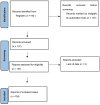Evaluation of Etiologies in Evisceration as Rare Cases: A 10-Year Single-Center Experience in the East Mediterranean Region of Türkiye
- PMID: 40429595
- PMCID: PMC12112041
- DOI: 10.3390/jcm14103601
Evaluation of Etiologies in Evisceration as Rare Cases: A 10-Year Single-Center Experience in the East Mediterranean Region of Türkiye
Abstract
Objectives: Evisceration is a rarely performed surgical procedure, and literature information regarding the characteristics of patients undergoing this surgery is limited. This study aims to evaluate the demographic features and etiological factors of patients who underwent evisceration surgery in a tertiary clinic over 10 years. Methods: This descriptive study comprised the data of 134 patients who underwent evisceration surgery at the Department of Ophthalmology, Faculty of Medicine, Çukurova University, Adana, Türkiye, between 2011 and 2022. Demographic data of all patients, including age, sex, surgical indication, etiology, primary disease location, pathology results, and follow-up periods, were recorded and analyzed. Results: The mean age of the 134 patients included in the study was 56.18 ± 22.71 (min: 8-max: 91), with a male-to-female ratio of 65.2% to 34.8%. Evisceration etiologies included trauma (37%), endophthalmitis (37%), absolute blind eye (12.6%), and spontaneous perforation (11.9%). Endophthalmitis cases were more common in older ages and females, trauma patients in younger ages and males, and spontaneous perforation in older ages and males. Progression to panophthalmitis was observed in 6.6% of all cases, and all were found to originate from endophthalmitis. Culture growth was positive in 18.5% of the cases, with the most commonly grown microorganisms in culture being Pseudomonas aeruginosa, Streptococcus dysgalactiae and Aspergillus fumigatus. Escherichia coli and Staphylococcus epidermidis rates were significantly higher in cases progressing to panophthalmia. Acute inflammation was more prevalent in cases of endophthalmitis and spontaneous perforation, while chronic inflammation was in cases of trauma and absolute blind eyes. Conclusions: Trauma was the main etiology of evisceration in young males and endophthalmitis in older females. Considering trauma prevention measures is important for public health in terms of eyeball saving.
Keywords: endophthalmitis; evisceration; eye removal; ocular trauma.
Conflict of interest statement
The authors declare no conflicts of interest.
Figures
Similar articles
-
Clinical Review of Ocular Traumas Resulting in Enucleation or Evisceration in a Tertiary Eye Care Center in Hungary.J Ophthalmol. 2021 May 27;2021:5588977. doi: 10.1155/2021/5588977. eCollection 2021. J Ophthalmol. 2021. PMID: 34136279 Free PMC article.
-
Clinical Review of Microbial Corneal Ulcers Resulting in Enucleation and Evisceration in a Tertiary Eye Care Center in Hungary.J Ophthalmol. 2020 May 18;2020:8283131. doi: 10.1155/2020/8283131. eCollection 2020. J Ophthalmol. 2020. PMID: 32509342 Free PMC article.
-
Outcomes of evisceration or enucleation by resident trainees in patients with recalcitrant endophthalmitis or panophthalmitis.Medicine (Baltimore). 2022 Jul 29;101(30):e29932. doi: 10.1097/MD.0000000000029932. Medicine (Baltimore). 2022. PMID: 35905216 Free PMC article.
-
To implant or not to implant: emergency orbital eviscerations with primary orbital implants.Eye (Lond). 2021 Nov;35(11):3077-3086. doi: 10.1038/s41433-020-01382-0. Epub 2021 Jan 11. Eye (Lond). 2021. PMID: 33432166 Free PMC article.
-
Outcomes of orbital implants after evisceration and enucleation in patients with endophthalmitis.Curr Opin Ophthalmol. 2010 Sep;21(5):375-9. doi: 10.1097/ICU.0b013e32833b7a56. Curr Opin Ophthalmol. 2010. PMID: 20489621 Review.
References
LinkOut - more resources
Full Text Sources



